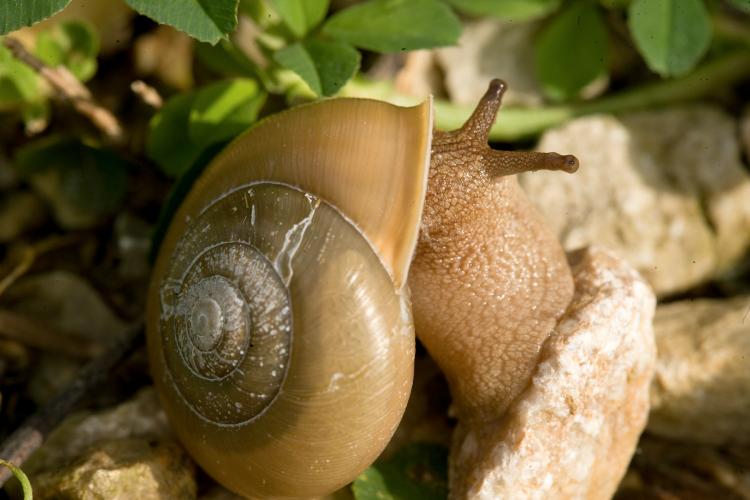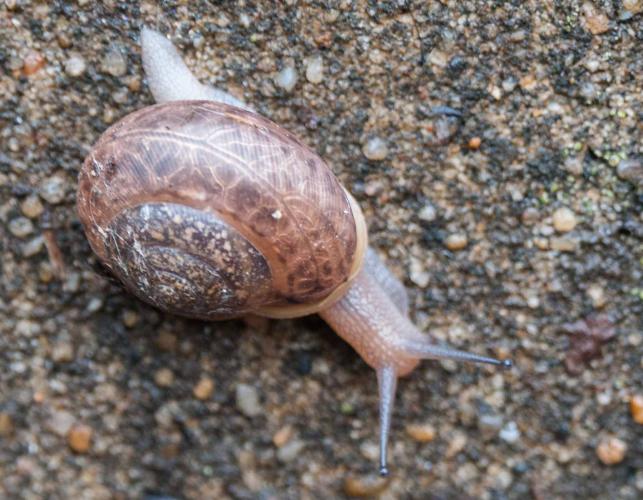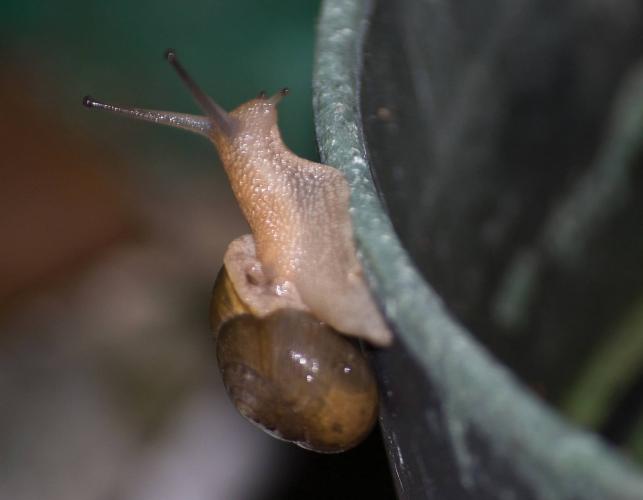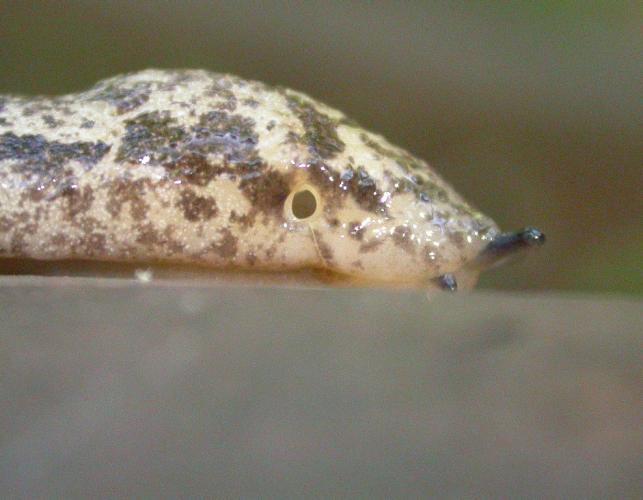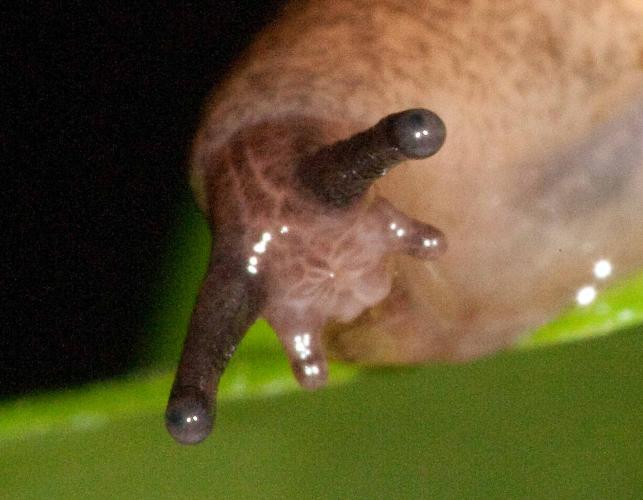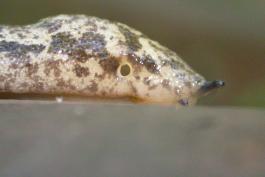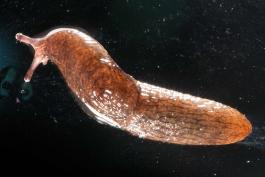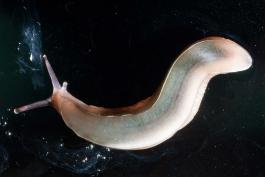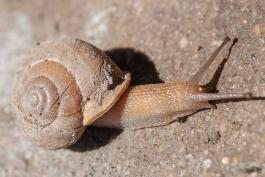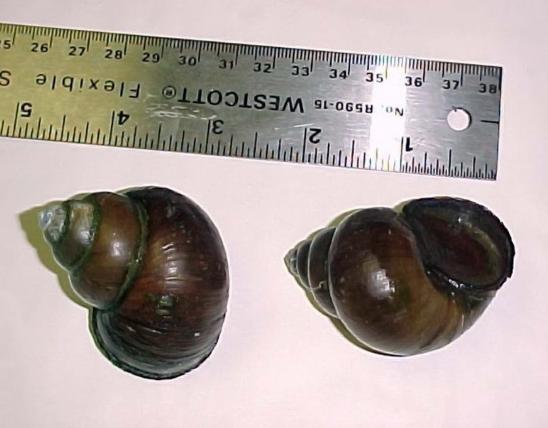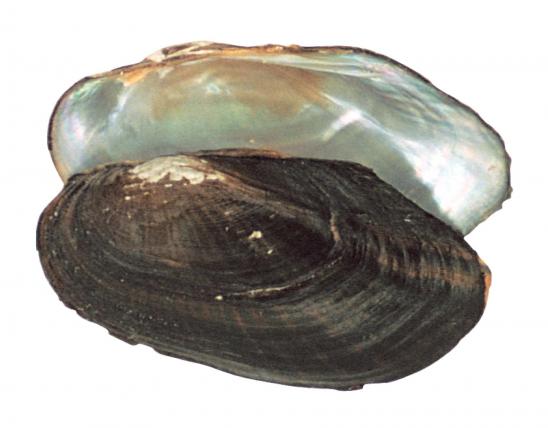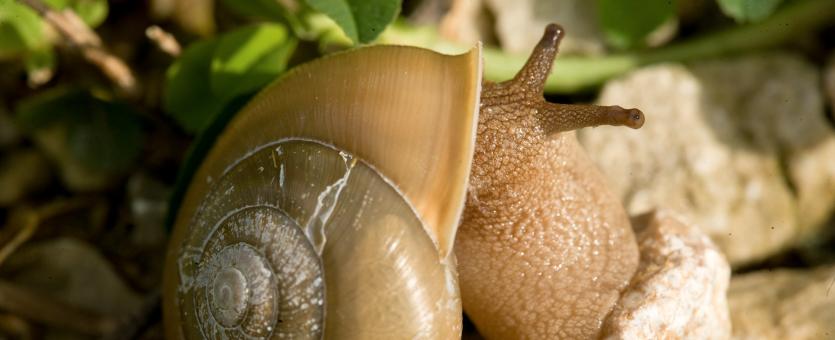
Most people recognize land snails and slugs when they see them: They have moist, soft, elongated bodies with a definite “foot” and a head with paired tentacles. Slugs lack visible shells, while snails have coiled shells composed of hard calcium carbonate. In a general way, the basic body form of snails and slugs is like that of other molluscs (limpets, squids, octopuses, clams, mussels, and so on), but snails have the distinctive spiral shell.
Slugs are essentially the same thing as land snails; they are simply land snail species that do not develop visible shells. Slug species occur in several snail families, so slugs and snails do not represent different taxonomic groups. Different slug species are usually identified by the different positions and configurations of the mantle and body openings.
Missouri has about 150 species of land snails and slugs in 25 families. This page is an introduction to the group as a whole. For a deeper look at their diversity, see R. D. Oesch, L. E. Watrous, and M. C. Barnhart's guide Land Snails and Slugs of Missouri (2013).
Mollusc shells are often used for identification because they are durable and have easily-seen characteristics, such as bumps, ridges, and spiraling traits. The aperture (opening) often has distinctive folds, teeth, and other projections. Most are drab white, tan, gray, or brown, but some species have red, yellow, or striped shells. Long after a snail has died, and even after the shiny, colored outer layer (periostracum) of a shell has been eroded, the different species can be identified by the bleached, white mineral portion of the shell.
Look closely at the structure of a snail shell: One key identifier for any snail is how the shell is coiled. Most snail species are “right-handed,” but some are “left-handed.” Here’s how to tell: If you hold the shell with the tiniest whorls (apex) facing you, and the spiral develops and widens in a clockwise direction, the shell is right-handed (or dextral). If it goes counterclockwise, then it’s left-handed (or sinistral). Each turn of the shell is called a “whorl.”
After the shell, the most obvious part of a snail is its muscular foot, with which the snail moves by waves of muscle contractions, aided by a layer of mucus. At the front of the body is the head, which has one or two pairs of retractable tentacles: The longer, upper pair bears the snail’s eyes; the shorter, lower pair is used for chemical sensing — taste and smell. The mouth faces downward; in it, the radula, a hard, microscopically toothed structure, scrapes at food like a little rasp.
Another organ, the mantle, is the material connecting the snail’s body to its shell; it protects the animal from drying out, and it secretes the calcium, proteins, and other shell-making molecules that, over time, enlarge the shell. You may see a hole in the mantle — that’s the pneumostome (NOO-mo-stome), which functions like a nostril; the animal breathes through it. Just behind the pneumostome is another hole — the anus.
Keep in mind that many snails are amphibious and can move in and out of water. Most land snails, and several types of aquatic snails, are pulmonates that breathe air via a lunglike pulmonary cavity between the body and the shell, protected by the mantle. Another group of snails, the prosobranchs, or gilled pond snails, are more strictly aquatic, though 3 species of land snails in Missouri are prosobranchs. They have tubelike siphons that draw water (not air) in and out of the mantle cavity, where gills extract oxygen from the water. Another identifier for gilled snails is that most of them have a hardened operculum (“trapdoor”) that closes the opening when they retract into the shell; this helps them to prevent drying out.
Shell length: ⅛ to 1½ inches; most are less than 1 inch (varies with species).
Statewide. Each species has its own distribution within the state, some being widespread and others quite limited.
Habitat and Conservation
Most land snails occur in a wide variety of habitats: wetlands, forests, prairies, and even deserts. Soils that are formed from limestone and other calcareous rocks are more favorable for land snails, because they provide the calcium they require for shell formation. In Missouri, some of the best habitats for land snails are wooded areas with limestone outcrops. If you are looking for land snails, turn over rocks, logs, and fallen bark, and inspect crevices at the base of large trees — especially walnut, butternut, buckeye, basswood, and sugar maple.
You can find land snails in urban settings, too. Check around the foundations of old buildings where they meet the ground, or under and around large rocks that have been left undisturbed.
Generally speaking, land snails are sensitive to dry conditions, so they are usually found in moist, shady, cool locations that offer the organic materials they eat. They are usually found among the leaf litter in forests, near the ground in moist fields, and in wetlands. As gardeners and landscapers know, they also live among vegetables and ornamental flowers.
Land snails have an interesting history. Biologists understand that the first snails (basically, molluscs with coiled shells) originated about 550 million years ago in saltwater. Later, some of these adapted to freshwater (via estuaries, where rivers meet the sea) and then to land. Thus the lunged (pulmonate) snails arose from gilled (prosobranch) snails that adapted to land; they include our common garden snails and slugs. The freshwater lunged (pulmonate) snails apparently represent descendants of land snails that readapted to life in freshwater.
“Slugness” — the condition of lacking a shell — arose independently in several groups of pulmonate land snails. Apparently, it offers slug species several advantages over their shelled brethren: without the bulky shell, they can enter into small places to hide, and they can burrow more easily; also, they might be able to survive without as much calcium in their diet or habitat.
Food
Most land snails apparently eat dead and decaying plant material, and associated fungi and bacteria. Others are herbivorous, grazing leaves, soft stems, fruits, vegetables, and flowers. More broadly speaking, land snails may eat a variety of foods: living or dead plants, rotting wood, algae, and fungi. They may also eat animal scat, tree sap, dead animals, and they may also obtain minerals necessary for building their shells by scraping on limestone rock, concrete, or snail shells. A few species are carnivores, eating earthworms, roundworms, or even other snails and their eggs.
At least one genus of slugs can quickly learn to avoid foods that are paired with some kind of unpleasant stimulus, and for weeks afterward, they will remember the association and continue to avoid the food, even when the unpleasant stimulus is removed.
Status
More than 100 terrestrial snails occur in Missouri, and there are more than 30,000 species globally.
Included among the land snails, Missouri has about 12 slug species, in 5 different families. About half of Missouri's slug species are introduced from Eurasia.
The following land snails are Species of Conservation Concern in Missouri, which means that they are vulnerable to becoming extirpated from our state:
- Black Mountain disc (Discus nigrimontanus)
- crested and slim snaggletooths (Gastrocopta cristata and G. pellucida)
- cherrystone snail (Hendersonia occulta)
- sealed globelet (Mesodon mitchellianus)
- Oklahoma liptooth (Millerelix deltoidea)
- Ozark whitelip (Neohelix divesta)
- engraved bladetooth (Patera perigrapta)
- inland slitmouth (Stenotrema stenotrema)
- eightfold pinecone (Strobilops affinis)
- post oak threetooth (Triodopsis cragini)
- perforate dome (Ventridens demissus)
- capital vertigo (Vertigo oscariana)
- dull gloss (Zonitoides limatulus)
Life Cycle
Snails are hermaphroditic, meaning that each snail possesses both male and female reproductive organs and can both “father” and “mother” offspring. When a pair of snails mate, they can fertilize each other, and after a period of gestation, each may lay a cluster of eggs. The number of eggs varies by species and by the age and size of the parent. Land snails typically deposit their eggs in clusters in a small hole they dig into damp soil. The young later hatch and disperse, needing food with plenty of calcium in order to develop strong shells. Land snails may live for a few years to well over a decade, depending on species and environmental conditions. Many land snails may enter a period of dormancy during the hottest part of summer or coldest part of winter.
Most snails have determinate growth, meaning that when the animal reaches maturity, it has a fixed size, always with a fixed number of shell whorls. The edge of the shell often folds back as the animal ceases growth. This is why the number of whorls can be a key feature for identifying species.
Generally, land snail species with a smaller body size tend to lay proportionately larger and fewer eggs (say, one or two large eggs at a time), while larger species lay clutches of several dozen relatively small eggs.
Human Connections
Gardeners often consider land snails pests, because they chew holes in leaves and may eat whole young plants. People have devised a variety of ways of dispatching or thwarting unwanted snails and slugs. Only a few species are serious pests, and our native species are seldom to blame. More often, the troublemakers are introduced European slugs (there are at least 6 species of them). Avoid slug baits with toxic metaldehyde. Formulations containing iron phosphate or methiocarb are less toxic, but beer traps and wet, folded newspapers (look online for tips) are not poisonous at all.
Despite the gardening issue, people consider snails as harmless, humble, and interesting creatures. Whimsical snail images are popular garden decorations. Snails don’t startle us with sudden moves, nor do they bite or sting.
A creation story of the Osage people (who used to live in Missouri before Europeans arrived) explains that the first human began life as a contented snail who led a leisurely existence along the Osage River. A severe storm and flood, however, carried the snail into a foreign place that was hot and dry, and the snail, embedded in drying mud, transformed into a man. The man found his way back to his former home, but he found life difficult: he was hungry, but he had no way to capture fish or game. Before he starved, however, the Great Spirit appeared, gave the man a bow and arrows, and taught him hunting skills. He would become the father of the Osages.
Snails are interesting animals to watch, and they are commonly used in science classes as students learn about biological diversity, ecology, behavior, and physiology. It’s easy to do this on your own. Start by placing a snail on a pane of glass and watch the waves of muscle contractions as it moves. If you shine a light behind the animal, you can see the snail’s heart beating, so you can measure its pulse, compare it to your own, and note changes in its rate as the temperature varies.
The slow movement of snails has long been used as a metaphor for slowness. “Snail mail” is one of the more modern allusions to the “snail’s pace.” A snail is on the logo of the international Slow Food organization. Snails have also been used as symbols for sloth, humility, a link to the sacred (their helical shapes are geometrically similar to Fibonacci’s spiral), perseverance and deliberation, being at home anywhere, and more.
Many human cultures prize certain types of land snails as food. When you consider that snail bodies are essentially the same as those of clams, mussels, abalone, conchs, and squid, it’s not as far-fetched as Americans might think. In France, the species Helix pomatia is the famous escargot de Bourgogne. The antiquity of snail eating has been proven by shells found at prehistoric archaeological sites.
Land snails can be used as indicators of calcium in the environment, even historically. Archaeologists have used evidence from ancient snail shells to learn about environmental conditions of long ago.
Land snails usually have a small home range, and because they collect pollutants in their bodies, ecologists can use them as an indicator for pollution in an area.
Don't be too creeped-out by a snail's slimy body. The moist bodies of snails and slugs are a lot like your own tongue: There’s a protective epidermal layer of living cells that’s kept moist by secretion of mucus.
Ecosystem Connections
Globally, there are more species of land snails and slugs than all the land vertebrates (amphibians, reptiles, mammals, and birds) combined.
Many vertebrate animals eat snails, including fishes; salamanders and other amphibians; turtles and other reptiles; shrews, mice and other mammals; and thrushes, grouse, turkey, and other birds. Toads may swallow snails and slugs whole. Brownsnakes have specialized jaws and teeth for pulling snails out of their shells. Shrews break through the spire of the shell, beside the opening, to extract the snail body. During winter, short-tailed shrews hoard live snails in specialized chambers of their burrows; they discard the empty shells in other special chambers.
More about snakes that are specialized for eating land snails: One study found the diet of midland brownsnakes was 75 percent slugs and 25 percent earthworms. Other researchers suggest that the blunt head and elongated teeth of this snake and the closely related red-bellied snake helps them to grip and tug persistently on a snail's body until the snail fatigues and can be pulled out of its shell. MDC's herpetologist Tom R. Johnson theorized that an unusual "lip-flaring" behavior of red-bellied snakes may help the snake control the slime while swallowing such slippery prey.
Invertebrates eat snails, too: mites, roundworms, and flies can parasitize them, and they are preyed on by several types of beetles and their young, centipedes and millipedes, and certain types of carnivorous snails. Top insect predators include the larvae of ground beetles, lightning beetles, flesh flies, and snail flies. Adult ground beetles can break snail shells with their strong jaws.
Because they accumulate calcium from the environment and collect it in the form of their shells, land snails can be an important source of calcium in the diet of several types of animals.
The roundworm Parelaphostrongylus tenuis uses land snails and slugs as an intermediate host. The snails and slugs ingest the larval form of the roundworm when they graze on the scat of infected deer, elk, or other cervids. When a deer or other cervid, browsing on plants, happens to consume a snail or slug that is host to the roundworm, the roundworm completes its life cycle inside the cervid, where it is called brainworm or meningeal worm. White-tailed deer are commonly infected, but they are mostly resistant and rarely show clinical signs. Elk, moose, and caribou, however, are often killed by it. As deer ranges have expanded northward, moose have been increasingly exposed to the roundworm, which is relatively new to them, and their populations have been declining. It is not a known health hazard to humans.
A number of exotic land snail species have been introduced to North America and have become invasive, negatively impacting the environment and agricultural interests.
